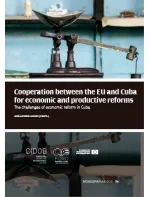The economic reform in Cuba: Stuck in the middle

Over the past decade, the Cuban economy has launched a sequence of reforms and stabilising measures to correct macroeconomic imbalances and establish a new growth model on the island. Thus far, any success achieved has been relatively limited. After over three decades of reforms, the Cuban economy continues to grow at a very slow pace, social deficits are accumulating and it exhibits a notable vulnerability to external shocks. The reform’s limited effectiveness to a large extent derives from its lack of comprehensiveness. Partial and fragmented in nature, the reforms have proven unable to produce sustained dynamism in the economy; and the necessary attempts to subsequently correct imbalances have tended to have recessionary effects that have damaged growth potential. For all these reasons, the Cuban economy appears to be trapped in a vicious circle. Escaping this trap means accepting more comprehensive economic reform that addresses the main distortions that prevent the market’s proper functioning in the fields of exchange rates, the labour market and wholesale supply, among others. This chapter seeks to provide some interpretations and evidence of this process.